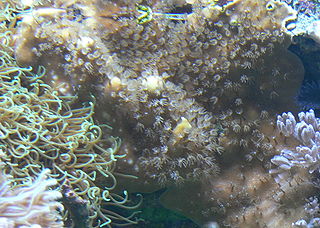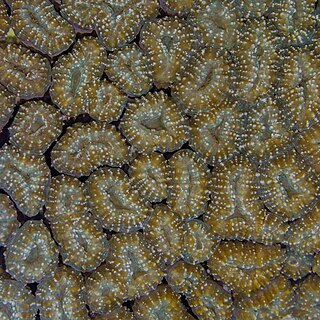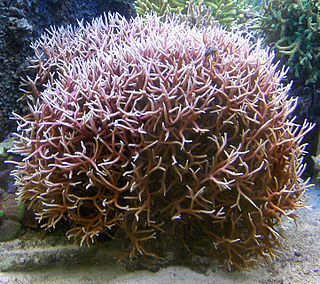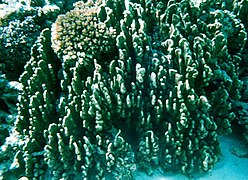
Corals are colonial marine invertebrates within the class Anthozoa of the phylum Cnidaria. They typically form compact colonies of many identical individual polyps. Coral species include the important reef builders that inhabit tropical oceans and secrete calcium carbonate to form a hard skeleton.

The organ pipe coral is an alcyonarian octocoral native to the waters of the Indian Ocean and the central and western regions of the Pacific Ocean. It is the only known species of the genus Tubipora. This species is a soft coral but with a unique, hard skeleton of calcium carbonate that contains many organ pipe-like tubes. On each tube is a series of polyps which each have eight feather-like tentacles. These tentacles are usually extended during the day, but will swiftly withdraw with any sort of disturbance. The skeleton is a bright red color, but is typically obscured by numerous polyps. Because of this, living colonies are typically green, blue, or purple due to the color of the expanded polyps. Colonies are typically dome-shaped and can reach up to 3 meters across, while the individual polyps are typically less than 3 mm wide and a few mm long. They are close relatives to other soft coral and sea fans. This species is a popular aquarium coral due to its ease to maintain, as well as higher tolerance compared to most true corals. However, its popularity presents a problem: along with its potential as an aquarium coral, the species' coloration makes it a popular commodity for tourists, leading to a variety of threats to the population.

Alcyonacea are an order of sessile colonial cnidarians that are found throughout the oceans of the world, especially in the deep sea, polar waters, tropics and subtropics. Whilst not in a strict taxonomic sense, Alcyonacea are commonly known as soft corals. The term “soft coral” generally applies to organisms in the two orders Pennatulacea and Alcyonacea with their polyps embedded within a fleshy mass of coenenchymal tissue. Consequently, the term “gorgonian coral” is commonly handed to multiple species in the order Alcyonacea that produce a mineralized skeletal axis composed of calcite and the proteinaceous material gorgonin only and corresponds to only one of several families within the formally accepted taxon Gorgoniidae (Scleractinia). These can be found in order Malacalcyonacea (taxonomic synonyms of include : Alcyoniina, Holaxonia, Protoalcyonaria, Scleraxonia, and Stolonifera. They are sessile colonial cnidarians that are found throughout the oceans of the world, especially in the deep sea, polar waters, tropics and subtropics. Common names for subsets of this order are sea fans and sea whips; others are similar to the sea pens of related order Pennatulacea. Individual tiny polyps form colonies that are normally erect, flattened, branching, and reminiscent of a fan. Others may be whiplike, bushy, or even encrusting. A colony can be several feet high and across, but only a few inches thick. They may be brightly coloured, often purple, red, or yellow. Photosynthetic gorgonians can be successfully kept in captive aquaria.

Helioporacea is an order of the subclass Octocorallia that forms massive lobed crystalline calcareous skeletons in colonial corals. These corals first appeared in the Cretaceous period. It consists of two families, Helioporidae Moseley, 1876 and Lithotelestidae Bayer & Muzik, 1977.

Heliopora is a genus of cnidarian in the monotypic family Helioporidae. It is a reef building hard coral but belongs to the subclass Octocorallia and is therefore most closely related to soft corals, sea pens, fan corals and sea whips and not to the main reef-building Scleractinian corals, which belong to subclass Hexacorallia. Currently only three species are known, one of which is known only from fossils:

Porites lobata, known by the common name lobe coral, is a species of stony coral in the family Poritidae. It is found growing on coral reefs in tropical parts of the Indian and Pacific Oceans.

Stylophora pistillata, commonly known as hood coral or smooth cauliflower coral, is a species of stony coral in the family Pocilloporidae. It is native to the Indo-Pacific region and is commonly used in scientific investigations.

Scolymia lacera, the fleshy disk coral, is a species of stony coral in the family Mussidae. It occurs on reefs in shallow waters in the Caribbean Sea, the Gulf of Mexico, the Bahamas, Bermuda and southern Florida.

Porites porites, commonly known as hump coral or finger coral, is a species of stony coral in the genus Porites. It is found in the Caribbean Sea and western Atlantic Ocean and also along the coast of West Africa.

Acropora cytherea is a stony coral which forms horizontal table like structures. It occurs in the Indo-Pacific Ocean in areas with little wave action, favouring back reef environments from 3 to 20 m depth.

Acropora pulchra is a species of colonial staghorn coral in the family Acroporidae. It is found on the back fringes of reefs in shallow water in the western Indo-Pacific Ocean. The oldest fossils of this species date back to the Pleistocene.

Mussa is a genus of stony coral in the family Faviidae. It is monotypic, being represented by the single species Mussa angulosa, commonly known as the spiny or large flower coral. It is found on reefs in shallow waters in the Caribbean Sea, the Bahamas and the Gulf of Mexico.

Lobophyllia corymbosa, also known as lobed cactus coral or brain root coral, is a species of large polyp stony coral in the family Lobophylliidae. It occurs on reefs in shallow waters in the Red Sea, off the coast of East Africa, and in other parts of the tropical Indo-Pacific.

Catalaphyllia is a monotypic genus of stony coral in the family Euphylliidae from the western Pacific Ocean. It is represented by a single species, Catalaphyllia jardinei, commonly known as elegance coral. It was first described by William Saville-Kent in 1893 as Pectinia jardinei.
Alveopora allingi is a species of stony coral that is found in the Red Sea, the Gulf of Aden, the southwest and northern Indian Ocean, the central Indo-Pacific, Australia, Southeast Asia, Japan, the East China Sea and the oceanic west and central Pacific Ocean. It has also been found in Palau and the Mariana Islands. It is susceptible to coral bleaching and is rated by the International Union for Conservation of Nature as a "vulnerable species".

Seriatopora hystrix is a species of colonial stony coral in the family Pocilloporidae. It forms a branching clump and is commonly known as thin birdsnest coral. It grows in shallow water on fore-reef slopes or in sheltered lagoons, the type locality being the Red Sea. It is native to East Africa, the Red Sea and the western Indo-Pacific region. It is a common species and the International Union for Conservation of Nature has assessed its conservation status as being of "least concern".

Heliofungia actiniformis is a solitary species of mushroom coral, a large polyp stony coral in the family Fungiidae. This coral is found in shallow water in the Indo-Pacific region. It is a zooxanthellate species. It is a popular coral in the reef aquarium trade; wild populations are threatened by disease, climate change, and over-collecting, and the species is considered vulnerable by the IUCN.
Euphyllia paradivisa, or branching frogspawn coral, is a species of large-polyped stony coral belonging to the Euphylliidae family. It shares the common name of "frogspawn coral" with Euphyllia divisa, but is differentiated as the "branching" frogspawn whereas Euphyllia divisa has a "wall" structure. It is a commonly kept species in the marine aquarium hobby.

Nanipora is a monotypic genus of cnidarian in the family Lithotelestidae. It consists of one species, Nanipora kamurai.
Goniopora tenuidens is a species of colonial stony coral in the family Poritidae. It occurs in shallow water in the tropical Indo-Pacific region. The International Union for Conservation of Nature has assessed its conservation status as being of "least concern".























